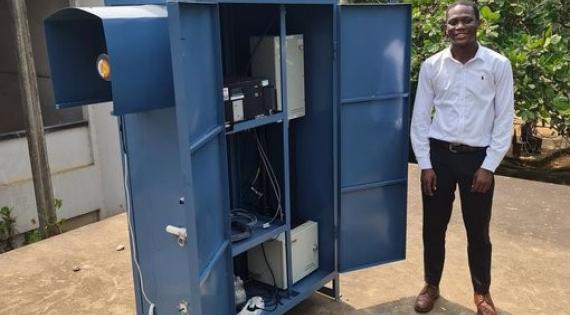Part two of a blog post by Gemma Purser about air quality monitoring equipment finding a new home in Africa and why it is critical to establish an air quality monitoring network on the continent. Read part one.
New location and different air...
On top of a building at the University of Cape Coast in Ghana, Africa stands a blue box, the new home of the reference air pollution instrument. Inside the pumps are running and through a small vent air is being sucked into the instrument once again. The air here is different to that in the UK. On some days the air is hot and dry, moving in from over the Sahara Desert region. On others, it is warm and humid, bringing in moisture as it moves from the tropical region over the south Atlantic.
There is another difference too - the sources of pollution are not the same. Like many regions of the world, poor air quality can have a huge impact on human health and understanding the sources of pollution are the first steps in making it better for the people who live there.
Meanwhile, the Kigali Collaborative Research Centre (KCRC) in Rwanda is busy preparing their TEOM instruments. Test deployments around Kigali bring in researchers from the University of Rwanda and Carnegie Mellon University. Prof Tim Brown from KCRC notes that more than just providing instruments, the UK team helps to ensure that the instruments can work now and into the future. With this support, the goal is to test and then deploy the instruments to partners in Rwanda and throughout East Africa through AfriqAir.
Africa qualité de l’air, also known as AfriqAir, is leading the establishment of a network of low-cost and importantly reference grade instruments like the ones from the UK in cities in Ghana and Rwanda. Twenty-five instruments have been sent to the network for installation. In addition, another 40 instruments were taken by the French Laboratoire Interuniversitaire des Systèmes Atmosphériques (LISA) group to be included as part of the International Network to study Deposition and Atmospheric composition in Africa (INDAAF) network.
Dr Mike Giordano from AfriqAir tells us why it's important to monitor air quality and establish a network for the region:
"Recent studies have estimated that there are at least hundreds of thousands, if not more than one million, premature deaths attributable to air pollution in Africa. These studies are potentially on the low end of estimates, however, because they rely on spatio-temporally sparse datasets. These data are usually from satellites or global atmospheric chemistry models (whose resolution is generally at best a few kilometres by a few kilometres), singular location monitoring efforts with daily or hourly averages, or simply emissions inventories. Unfortunately, using these datasets means that estimates on overall air quality impact may be biased by the location of the monitoring (e.g, singular monitors being in rural or semi-urban areas), satellite retrieval algorithms that are calibrated for the Global North instead of various parts of Africa, or inventories that are simply incomplete.
Building air quality networks in Africa is necessary both to estimate the total impact of air pollution and to begin combating the problem."
Another important activity of AfriqAir is to establish air quality monitoring stations in a wider range of locations.
@GhanaAQ has installed TEOM 1400ab at @UCCGH_Official Cape Coast. The very first reference monitoring of any kind outside of Accra. Next stop is Accra and Tema. @AfriqAirQuality @CEH_AirQuality @ChrisBraban @rob_pinder @subu_caps pic.twitter.com/89P508kfWW
— Kofi Amegah (@kofiamegah) August 2, 2021
Dr Kofi Amegah from University of Cape Coast, Ghana, shares on Twitter how one of the instruments from the UK is now being used to record air quality information for the first time ever at a location outside of the capital city, Accra. He told us:
“The donation of TEOMs to the Ghana Urban Air Quality Project (GHAir) which I lead through the AfriqAir network is critical to bridging the air quality data gaps in Accra and other metropolitan areas of Ghana to elicit sustained investment in air pollution control for population health gains. In close collaboration with the Accra city authorities, we have installed two TEOMs at the Accra City Hall and Kwame Nkrumah Circle Interchange, and another at the University of Cape Coast which is the very first regulatory monitoring of any kind outside of Accra. We are grateful to Christine Braban and the team at UKCEH for the effort in getting these TEOMs to Africa where air quality monitoring is weak or non-existent."
